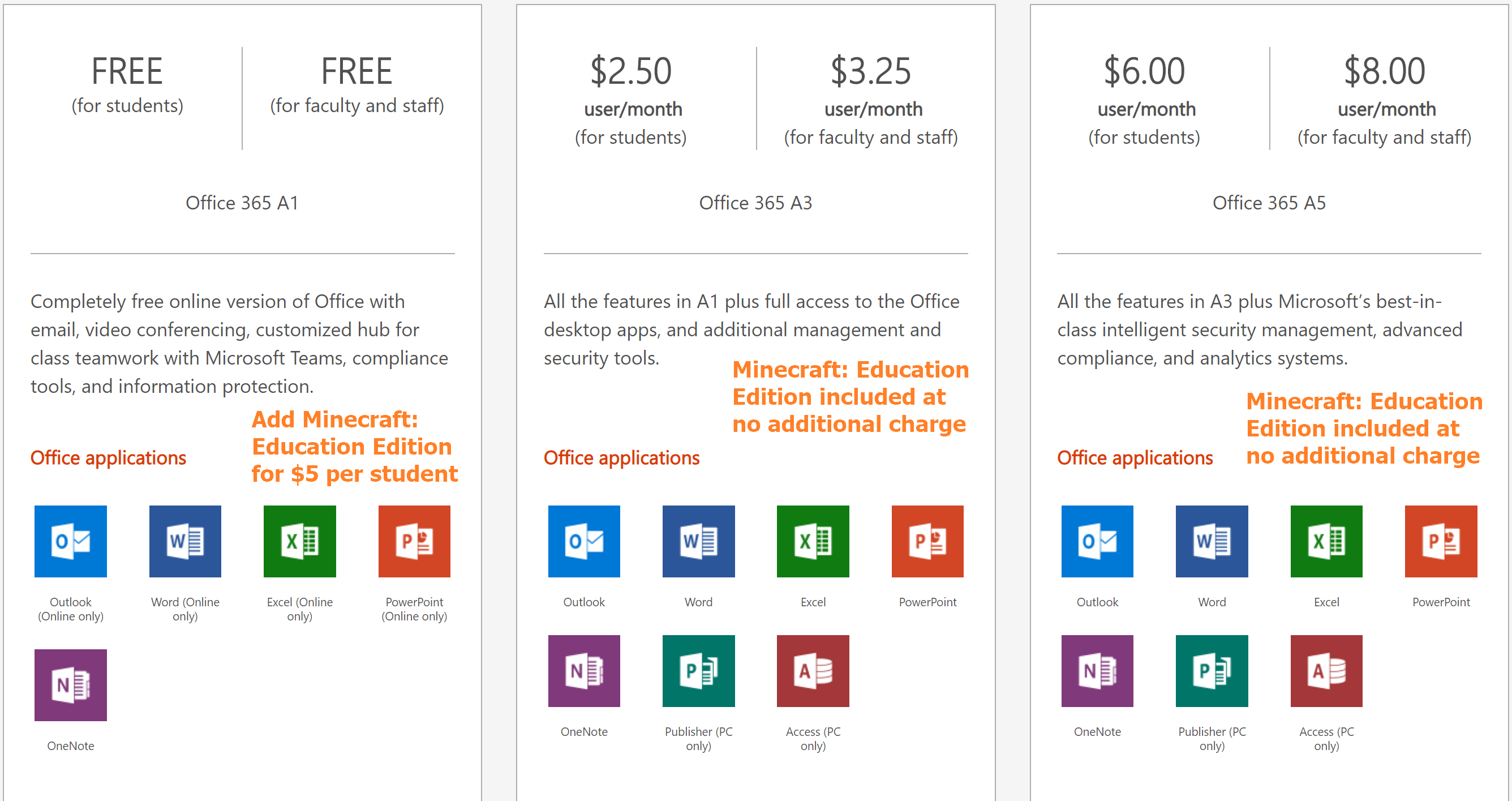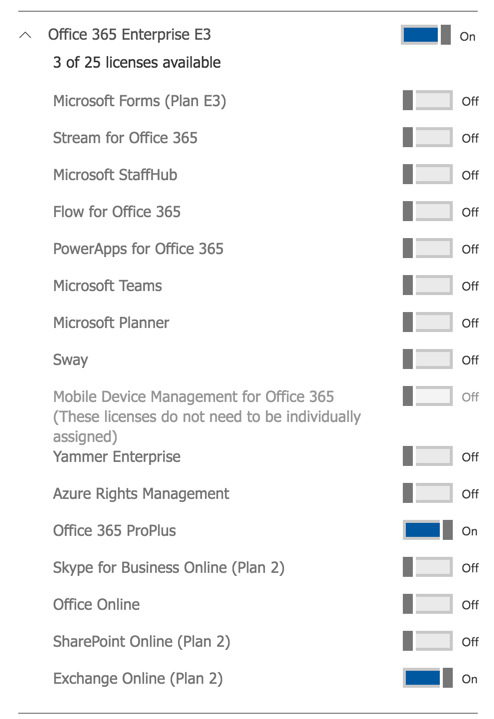Office 365 and Microsoft 365 Apps enables you to create, share, and collaborate from anywhere on any device with a cloud-based suite of productivity apps and services. Microsoft 365 Apps for enterprise Buy now for CAD $16.00 user/month. Mac os x leopard iso download. If you are reading this post, you were probably searching the web on how to get a detailed license report for your users in Office 365. Well you have come to the right place! Although you can get a license report from the Office 365 Admin Center; this report will give you the license packs assigned to each user, and not a list of services that. Microsoft 365 F3 Licensing Comparison to Office 365 F1. At only $10/user, firstline workers, employees that only need email, and contractors are a few types of users that would benefit from the Microsoft 365 F3 license. The business value for investing in M365 F3 licenses include.
Understanding Microsoft 365 and Office 365 license types is important for saving money and ensuring employee productivity. But, many companies are improperly licensed.
Often, this is because licensing guides are unclear – leading to under-or over-licensing. Microsoft’s own pricing web pages are a maze and generally unhelpful. It is difficult to find a side-by-side view of all business and enterprise license types, including features and pricing.

To simplify things, we’ve created a license cheat-sheet. It includes:
- Overview of common Office 365 (and Microsoft 365) license types
- FAQ insights from one of Cleanshelf’s Microsoft licensing specialists
Common License Types Overview

Microsoft Office 365 labels itself as the world’s foremost “productivity cloud.” Individual users can benefit from access to business standard essentials like Word, Excel, Powerpoint, and OneNote, as well as email and calendar with Outlook and Bookings. Free cleanmymac x activation code.
Increasingly, companies are consolidating app vendors for chat, storage, and task management. If moving away from competing services like Slack or Box, companies may opt for licenses that include OneDrive, Teams, Sharepoint and To Do.

| License Type | Target | Pricing | Feature Overview |
| Enterprise (Support greater than 300 users) | |||
| Microsoft 365 Apps (formerly Office 365 ProPlus) | Enterprise | $12 user/month (annual commitment) | Enterprise edition of the Office apps plus cloud-based file storage and sharing. Business email, social apps, and Teams not included |
| Office 365 E1* | Enterprise | $8 user/month (annual commitment) | Includes business services (email, file storage and sharing, Office for web, meetings, and IM, but not Office apps. |
| Office 365 E3* | Enterprise | $20 user/month (annual commitment) | All Office apps and business services, plus meetings, social, email and calendar, as well as security, compliance, and limited analytics. |
| Office 365 E5* | Enterprise | $35 user/month (annual commitment) | All features of E3, plus advanced security, full analytics (MyAnalytics, PowerBI Pro) and voice capabilities. |
| Microsoft 365 F3 (formerly F1) | Enterprise | $10 user/month (annual commitment) | Increasingly common front line worker licensing type; email and cloud storage, plus Office web and mobile apps. |
| Business (Support up to 300 users) | |||
| Microsoft 365 Business Basic (formerly Office 365 Business Essentials) | Businesses (< 300 employees) | $5 user/month (annual commitment) | Includes web and mobile versions of Word, Excel, and Powerpoint, plus Microsoft Teams and cloud storage. Desktop versions of Office apps not included. |
| Microsoft 365 Business Standard (formerly Office 365 Business Premium) | Businesses (< 300 employees) | $12.50 user/month (annual commitment) | For businesses that need Office apps across devices, plus business email, cloud file storage, and online meetings and chat. |
| Microsoft 365 Business Premium (formerly Microsoft 365 Business) | Businesses (< 300 employees) | $20 user/month (annual commitment) | Includes everything in Business Standard, plus advanced cyberthreat protection and device management with Intune and Azure Information Protection. |
| Microsoft 365 Apps (formerly Office 365 Business) | Businesses (< 300 employees) | $8.25 user/month (annual commitment) | Offers Office apps across devices and cloud file storage. Business email, calendar, and Teams not included. |
*Note: we display Office 365 E1, E3, and E5 above as many clients and prospects have these licenses and Microsoft continues to offer them. However, Microsoft has updated this line to include Microsoft 365 E5, E3 and F3. These add intelligent experiences, enterprise-grade management, and advanced security features – but are priced substantially higher.
Visio Office 365 License Cost
Find a brief comparison of Office 365 E3 vs. Microsoft 365 E3, with an included license for Windows 10 Enterprise & Microsoft Intune (enterprise mobility security package) being the biggest major difference between them.
Insights from Cleanshelf’s Microsoft Licensing Expert
Below, Dejan Sraka, Cleanshelf’s head of Engineering, answers key questions on smart licensing with Office 365 and Microsoft 365. He’s worked closely with more than fifty companies in eight industries to successfully utilize Saas services and Office/Microsoft 365 deployments.
What licensing type is recommended?
Office and Microsoft 365 are available with various services bundled in the offered license packages. To pick the right license, consider the following:

Office 365 Licenses Cost
- Are you already using any comparable services?
- Would services bundled in the packages complement or replace already actively integrated and used services? Are there any bundled services not needed?
- What are the implementation/replacement costs for the services from the bundle?
- How willing are you to integrate your business tightly into a whole Microsoft suite?
In addition to answering these questions, review service usage data (offered by Cleanshelf). This boosts license type decision making with concrete data.
Should I mix licensing types?
It is common for companies to mix license types as access, feature, and function needs vary by employee type and role. This is why it is essential to do a thorough inventory of your current environment before deployment of Microsoft 365 solution. This step should also include the discovery of similar, existing services already in use and agreement on whether they will remain in use after the deployment of Microsoft 365. Keeping or leaving comparable services influences the decision on which license type is required for each employee type.
Where do you see clients waste money with unused functionality?
Businesses often buy bulk licenses but only use a subset of a license’s available functionality. In other cases, companies underbuy and limit the productivity of key staff. Buy-to-fit is the best way to ensure cost efficiency without inhibiting work efforts. But this requires understanding who you’re buying for, where licenses exist, and what the use case is.
Office 365 Licenses F1
Once these are defined, monitor adoption and ongoing use. It is not enough to buy based on security features, for example, and select Microsoft 365 E5 version. You may find that only twenty percent of staff use the security functionality and that less than half of employees ever activate their Microsoft Apps suite. Schedule quarterly reviews to ensure proper license assignment.
Office 365 Licenses Explained
What are other businesses and enterprises doing to improve productivity, license management, or cost-savings?

Businesses manage SaaS by creating adoption and migration plans. Mac os x lion download dmg. With tools like Cleanshelf, it's much easier to track adoption and usage.
For example, we saw one enterprise buy Office E5 licenses for the majority of its employees. Yet, less than one percent of employees utilized the license’s advanced security features. More than eight percent of employees were never assigned a Microsoft 365 Apps license, and only seventy-six percent of users actually activated the product. Many users could have downgraded to an F1 license without losing needed functionality.
We helped the customer understand the situation, potential cost-savings, and underutilization. SaaS visibility helped them adjust licenses and add processes to achieve smarter adoption.
Interested in optimizing your existing Microsoft licenses?
Check out this five-step guide to license optimization. The article, written by Dejan Sraka, Head of Engineering, Tools, and Automation at Cleanshelf, includes a bonus template to help companies baseline user data. This is the critical first step to right-size license deployments and mix.
Related Resources
